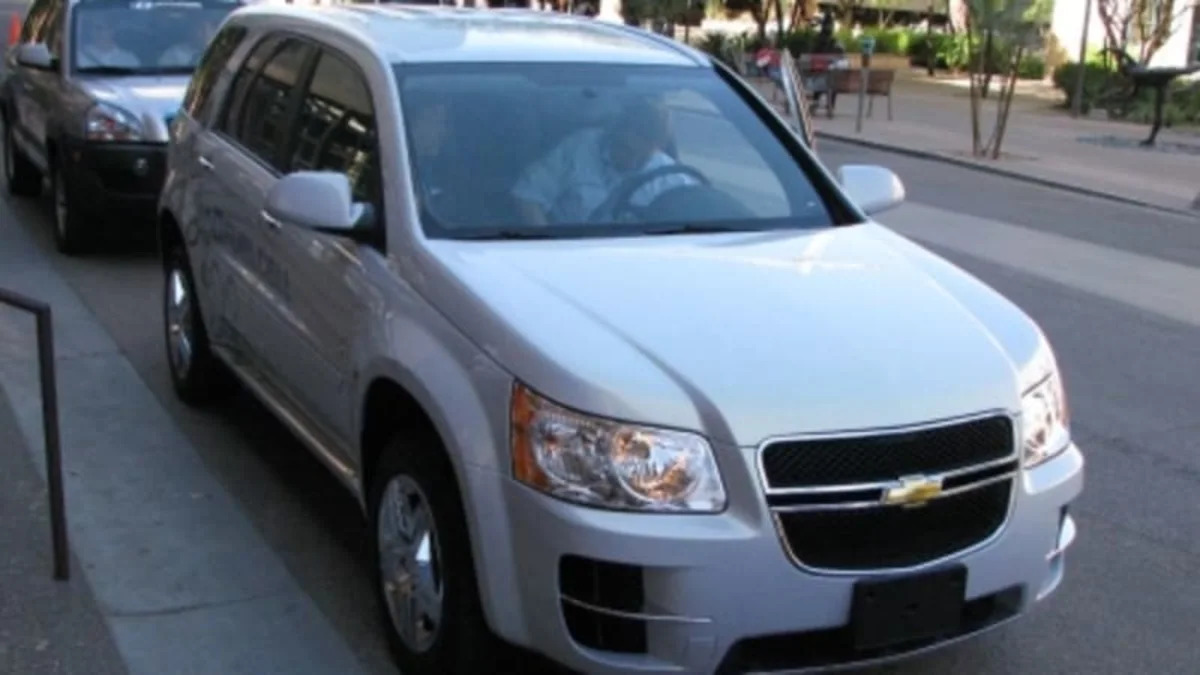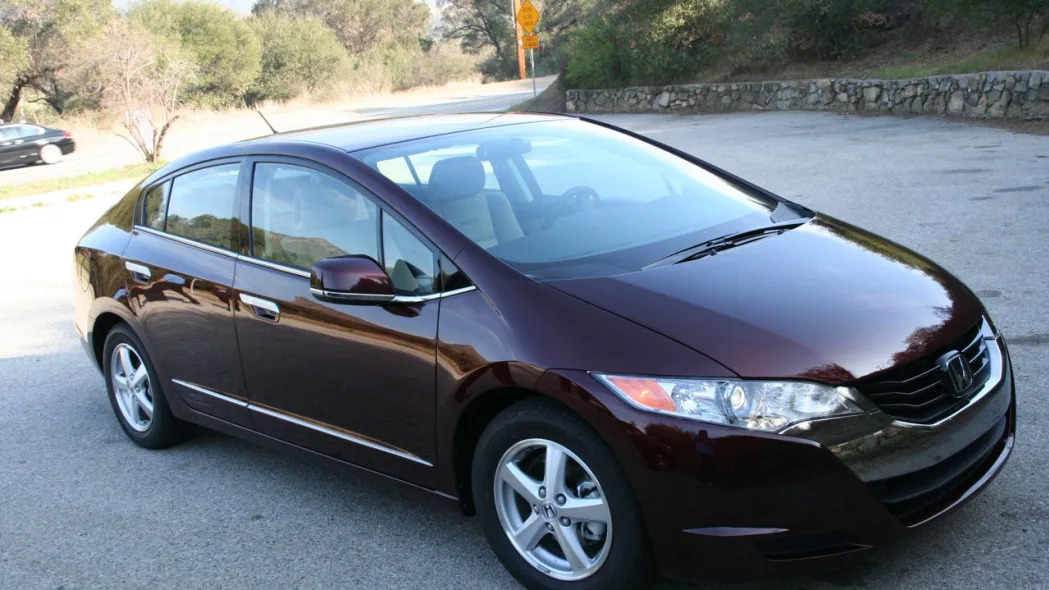Click above for more shots of the GM HydroGen4 fuel cell Equinox
The hydrogen economy seems to be very far away into the future, if it ever comes to fruition at all. If hydrogen is going to make a significant impact as a major source of energy, an infrastructure for getting the hydrogen to consumers will be a necessity, as will the solutions to complex problems such as where to extract the hydrogen from and how to store it in large quantities. Perhaps you can tell that we believe all of this will take time, but there is still a large contingent of hydrogen proponents that believe the hydrogen economy will indeed come to pass, and some cite examples of current hydrogen-powered cars as proof. How do these cars drive? We recently got the chance at the Fuel Cell Seminar & Exposition in Phoenix, Arizona to get some seat time in a few of the hydrogen cars that are currently being tested by major automakers, including the Daimler F-Cell, Hyundai FCEV, the latest Toyota FCHV and the GM HydroGen4 fuel cell Equinox. Read on after the break for our first impressions.
All Photos Copyright ©2008 Jeremy Korzeniewski / Weblogs, Inc.
Hyundai FCEV:

The first car we got behind the wheel of was from Hyundai. The Korean automaker has been experimenting with hydrogen fuel cells for a few years now and has just recently created its own fuel cells without assistance from an outside organization. The FCEV we drove had quite a few miles on it and featured this brand-new Hyundai designed and built fuel cell. The vehicle itself is based on the Tucson SUV, which has plenty of room for the associated hydrogen tanks, batteries, electric motor and, of course, the fuel cell stack itself due to its ample storage capacity. All fuel cell vehicles are really powered by electricity, and the FCEV drove exactly as you'd expect an electric car to do. We felt instant torque right from a stop. The steering, though, felt extremely artificial and would never pass on a production vehicle. We also noted what felt like fairly extreme regenerative braking just a moment after taking our foot off the gas. Still, the car was very easy to drive once we adapted our driving techniques to the car's behavior. From behind the wheel, most people wouldn't know the difference between the FCEV and its gas-powered sibling, except for the complete lack of engine vibration when at "idle." An LCD screen in the center of the dash offered various readouts of battery level, hydrogen level and the like. Hyundai was very proud of the fuel cell's 5-second start-up time, which they claim is better than most competitors.
Daimler F-Cell:

Next, we got behind the wheel of the Daimler F-Cell, which is based on the A-Class. Make no mistake, this is a very small car. It's also pretty cheap and we could definitely sense its economy car roots as we slid behind the wheel. There was an LCD readout that showed where the car's motor was getting its power from. At a stop, the hydrogen fuel cell reading indicated that 5 percent of its power was powering the car, which could have had something to do with the air conditioning that was running. (It was over ninety-degrees and sunny in Phoenix.) The steering in the F-Cell felt rather heavy and its acceleration felt very weak. The 88-horsepower electric motor is supposed to be able to propel the car to 85 miles per hour, but we'd need to see that to believe it. This definitely seemed like an engineering vehicle more than a car meant to drive. We noted quite a bit of road noise on our short drive through downtown. Still, everything worked as you'd expect from a normal car and we had little problem adjusting ourselves to the car's unique driving experience. When we pulled back into the line, though, we were happy to get out of the F-Cell and into the Toyota.
Toyota FCHV:

Toyota has a long history of FCHV vehicles. Starting in 1996, the huge Japanese company has been working on the assorted hydrogen hurdles and has since accumulated hundreds of thousands of miles of testing in hydrogen vehicles. The automaker's latest fuel cell vehicle is the FCHV-adv, and that's what we drove. There is an on-board 10,000 psi compressed hydrogen storage system and a nickel metal hydride battery pack, which conspire to power the car with no problem at all. Based on the automaker's last-gen Highlander SUV platform, the FCHV felt like a rather refined vehicle, and its electronics were very advanced. A readout in the dash gave more information that we were ready to decipher in our short stint, but would prove invaluable for engineers. The driving experience proved unexciting, which is a good thing considering the high-technology powertrain that makes the vehicle operate. We did not have the air conditioning running in the Toyota as we did in the others, and we wonder if that makes any difference in how the car drives. In any case, we feel that anybody could get behind the wheel of Toyota's latest FCHV and have no problem piloting the vehicle and would likely never know anything was different about it compared to most any other car they've driven.
GM HydroGen4 fuel cell Equinox:

The last driving impression was also by far the best. Getting inside the HydroGen4 from General Motors proves that the automaker has an excellent fuel cell platform to work with. On the outside, the hydrogen car looks very much like a standard Equinox, minus the chrome slits at the rear where the steam exhaust is released, but the entire drivetrain under its hood has been replaced with a fuel cell stack, motor, motor controller and inverter. A nickel metal hydride battery pack sits under the middle of the vehicle and offers a capacity of 1.8kWh and an output of 35kW. Three carbon fiber storage tanks sit at the rear and hold hydrogen compressed to 10,000 psi. The car drove beautifully, with no hint that there was something different powering it. Acceleration felt very good, and there was a constant rush of torque right from the start that continued to the maximum velocity we could attain on the urban test drive. There is an LCD gauge in the center of the dash that offers both navigation and a power indicator. We ran the air conditioning at all times and it did not seem to affect performance in any meaningful way. By the time we parked the fuel cell Equinox, we were convinced that the General had done its homework in making a hydrogen-powered car that seems ready for the masses. Of course, GM is in fact letting a number of people drive the cars as their daily transportation through its Project Driveway initiative, which proves that believes its car is ready for prime time. Still, the cost must dramatically go down before a vehicle such as this is ready for the showroom floor. For now, don't hold your breath.
We also got behind the wheel of the Honda FCX Clarity, and found it extremely capable as well. We've had the chance to drive the Clarity before and have previously posted our in-depth driving impressions. Click here for the whole story.
The moral of this story is that the technology is definitely here for hydrogen fuel cell vehicles. There was nothing that felt all that remarkable about our driving experience in any of these vehicles, and that applies especially to the GM HydroGen4. Still, the hurdles of capturing, transporting and storing hydrogen loom large as problems that must be addressed if hydrogen is truly going to offer a meaningful alternative for transportation. Another big problem is with cost, as each of the vehicles we piloted is well out of the price range of most every driver in the world. Still, the fact is that these cars are very important testing platforms and they work exactly as advertised. For that, Hyundai, Daimler, Toyota, General Motors and Honda all deserve major kudos.
All Photos Copyright ©2008 Jeremy Korzeniewski / Weblogs, Inc.



Sign in to post
Please sign in to leave a comment.
Continue